Grab cheap eSIMs, SIMs, and portable WiFi. Stay connected anywhere!
🔥 Travel Discounts Worldwide
Find latest hot deals on flights, hotels, attractions, and more across different regions!
🚆 Hot Transportation Deals
Get up to 10% OFF Coupon on train tickets in many countries!
Save 10% on car rentals
Check out weekly flight deals & save big!
🎡 Attractions & Discounted Tickets
Enjoy deals on tickets to popular attractions around the globe. Explore more for less! 🎟️
Brief Introduction to Kyoto
Kyoto, the former imperial capital of Japan, is a city rich in history and culture. Situated in the heart of the island nation, it has been the epicenter of Japanese civilization for over a thousand years. Today, it remains one of the most popular destinations for travelers from around the world. Kyoto has a deep and fascinating history. The city was founded in 794 AD as Heian-Kyo, which means "capital of peace and tranquility." It was the hub of politics and culture during the Heian Period (794-1185), and it served as the emperor's residence until the capital was later moved to Tokyo in 1868.
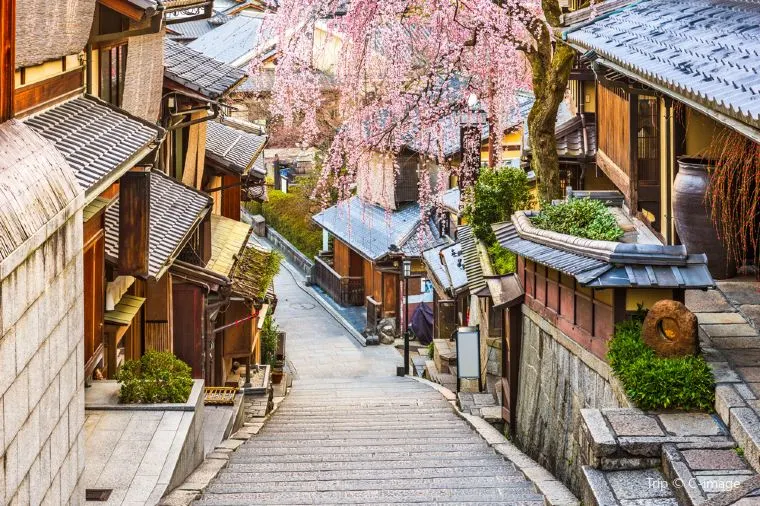
Sannenzaka & Ninenzaka. Source: Trip.com
The city is home to multiple temples, shrines, and other historical landmarks, making it one of the best places in Japan to experience traditional Japanese culture. Among the renowned Kyoto temples, there is one called Kiyomizu-Dera, a UNESCO World Heritage Site and one of the most visited temples in Kyoto, and the Fushimi Inari Taisha, which boasts thousands of bright red torii gates lining a winding path up to a mountain.
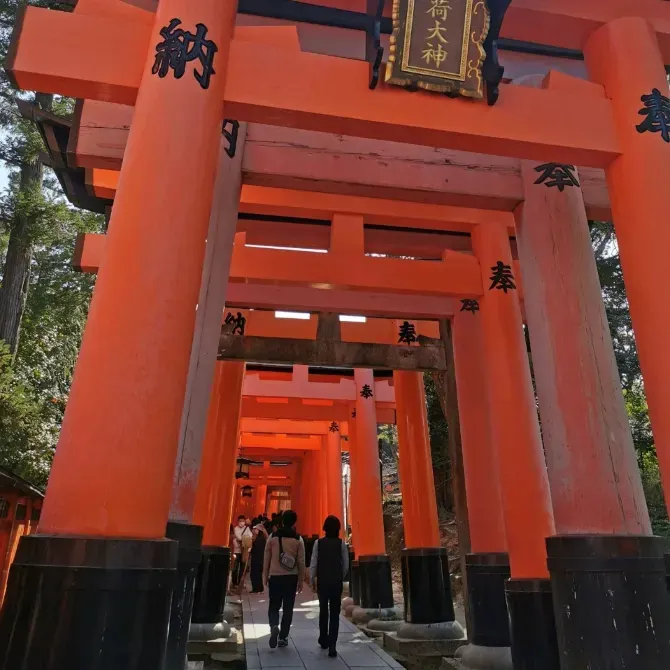
Fushimi Inari Taisha. Source: Trip.com@LMOOLM
How can I get to Kyoto?
Visitors can arrive at Kyoto by landing at the Kansai International Airport or Osaka International Airport and then taking a train or bus to Kyoto Station. From there, public transportation, such as the Kyoto City Bus and Kyoto Subway, makes sightseeing much easier. If you're coming from Tokyo, the Shinkansen (bullet train) to Kyoto Station takes about 2 hours and 20 minutes. You can also take a detour from Tokyo to Osaka and then take a train or bus to Kyoto.
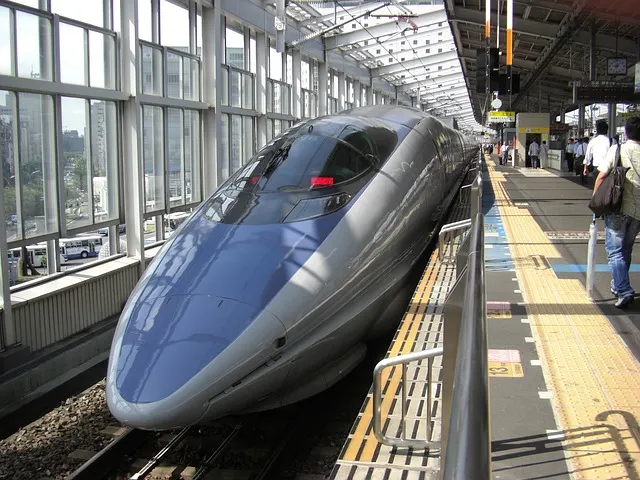
A bullet train in Japan. Source: Y HOSOKAWA from Pixabay
In addition to its rich history and cultural heritage, Kyoto is also renowned for its natural beauty. The city is surrounded by mountains and is famous for its cherry blossoms in the spring and bright foliage in the fall. Visitors can take a stroll through the city's parks and gardens, such as the tranquil Arashiyama Bamboo Grove.
Kyoto is a destination that appeals to travelers of all demographics. Whether you are interested in history, art, nature, or cuisine, Kyoto has something for everyone. Its timeless beauty and culture make it a must-visit destination for anyone traveling to Japan.
Top 20 Temples in Kyoto
👉 In this article, we will unveil the top 20 Kyoto temples that are guaranteed to leave you mesmerized and in awe of Japan's rich history and culture.
1. Kiyomizu-dera

Visitors at a temple in Kyoto. Source:Michelle Raponi from Pixabay
One of the most famous and charming temples in Japan would be Kiyomizu-dera Temple, which is located in the center of Kyoto. This beautiful UNESCO World Heritage Site provides tourists with spiritual and historical enlightenment. The wooden stage that protrudes from the temple's main hall and provides panoramic views of the city is its selling feature. Visitors can test their luck by moving from one pillar to another while keeping their eyes shut. The stage is supported by 139 pillars. It is said that your wish will come true if you can get from one pillar to the next safely.
Kiyomizu-dera Temple is located in the eastern part of Kyoto, on the slopes of Mt. Otowa. Visitors can reach the temple by taking a bus from Kyoto Station to Gojo-zaka or Kiyomizu-michi bus stop and then take a 10-minute uphill walk to the temple. The temple is open daily from six in the morning to six in the evening. The entrance fee for adults is about $4, while children under 12 can enter for free.
In addition to the wooden stage, Kiyomizu-dera Temple is home to a plethora of sites, such as the Main Hall, the Jishu Shrine, and the Otowa Waterfall, where visitors can drink from three streams of water, each of which was said to have special health advantages. And during the lovely springtime, this Kyoto temple is one of the many popular locations for viewing cherry blossoms blessed with good will.
Address: 1-chōme-294 Kiyomizu, Higashiyama Ward, Kyoto, 605-0862, Japan.
2.Kinkakuji Temple
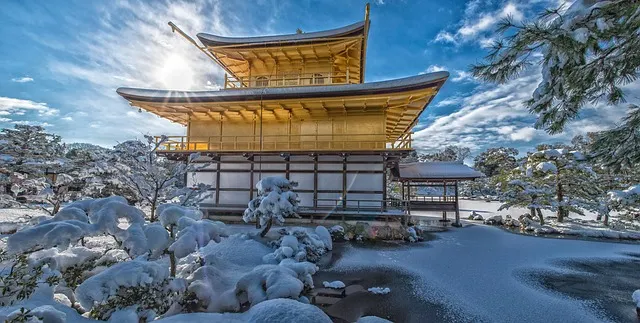
A view of Kinkakuji Temple after snow. Source: Kanenori from Pixabay
Kinkakuji, also known as the Golden Pavilion, is among the most breathtaking temples in Kyoto, Japan. The temple's most striking feature is the stunning golden pavilion that sits atop a tranquil pond, reflecting the temple's beauty and creating a serene atmosphere. Kinkakuji is not just a temple. A visit there will surely leave a lasting impression on your heart and mind.
In addition to its appearance, Kinkakuji temple has a long and illustrious history that dates back to the 14th century, when it was initially constructed as a retirement home for a shogun (Japanese for "general"). The shogun's son later transformed that place into a Zen temple, and it has since been one of Japan's most iconic buildings.
Situated in northern Kyoto, the temple is open daily from 9AM to 5PM and is easily accessible via public transportation, and is open to visitors year-round. Seasonal differences in ticket costs result in higher costs during peak season than off-season. But the opportunity to visit this majestic temple up close is well worth the cost. General admission costs 500 yen (around $3.8), while admission for Primary and Middle School Students costs 300 yen (around $2.25)
Address: 1 Kinkakujicho, Kita, Kyoto, 603-8361, Japan
3.Yasaka Shrine
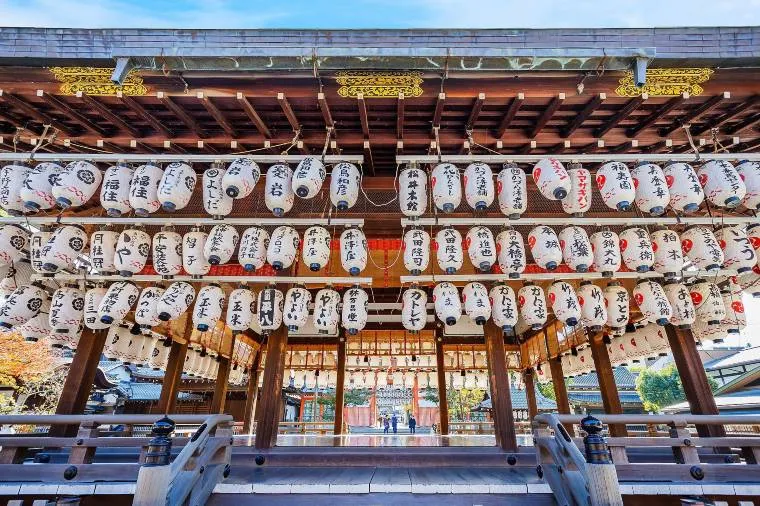
Yasaka Shrine in Kyoto. Source: Trip.com
For anyone visiting Kyoto temples, Yasaka is not something to be missed. Often referred to as the Gion Shrine, this historic shrine can be found right in the middle of the city and serves as a reminder of Kyoto's vibrant past. The magnificent vermilion-painted gate is the shrine's most prominent feature and also serves as the grand entryway to the complex. You will be taken to a peaceful and quiet realm as soon as you pass through the gate. The shrine's building organically blends Chinese and Japanese design elements in harmony for a unique and striking appearance.
Originally built in the 7th century, Yasaka Temple has been a site of worship and pilgrimage for centuries. Visitors can learn about the rich history of the temple and the traditions of Japanese Buddhism by taking a guided tour or simply exploring the grounds of their own volition. Admission tickets to this temple in Kyoto cost around $5 per person, and it is open daily from 6AM to 6PM, making it easy to fit into any travel itinerary.
Address: 625 Gionmachi Kitagawa, Higashiyama Ward, Kyoto, Kyoto Prefecture 605-0073, Japan
4.Fushimi-Inari-Taisha Shrine
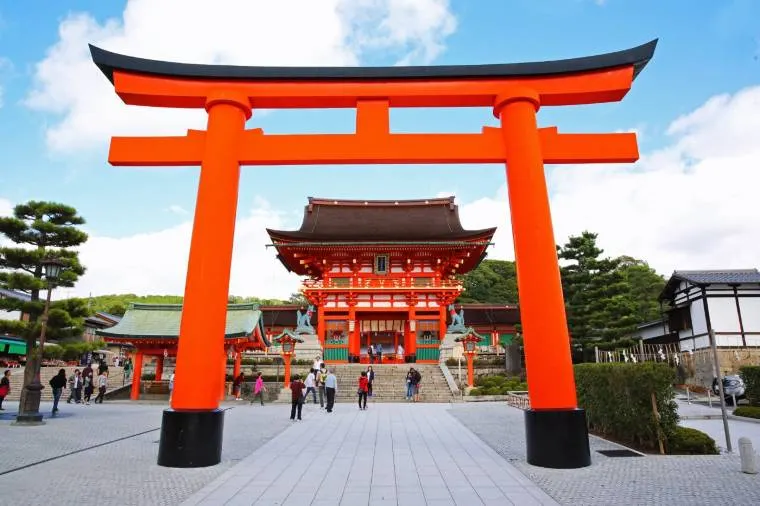
Entrance to Fushimi-Inari-Taisha Shrine. Source: Trip.com
Fushimi-Inari-Taisha Shrine ought to be the top dog on your list if you're looking for a unique and unforgettable memory in this fine Kyoto temple. Not only is this magnificent shrine one of the most popular temples in Kyoto, but it is also a profoundly spiritual and uplifting destination.
The thousands of torii gates that wound their way up the mountain behind Fushimi-Inari-Taisha Shrine are its most notable feature. Visitors can spend hours exploring the trails that run through the vivid orange gates and up the mountain, which create a beautiful tunnel effect.
If you want to visit Fushimi-Inari-Taisha Shrine, you can do so for free. The shrine is just a short train journey from Kyoto Station and is accessible via public transit. If you're interested in the history and culture of Japan or are simply looking for a serene place to explore, this Kyoto temple is sure to make you drop your jaw. So, pack your camera and get ready to discover the beauty and wonder of this eminent Fushimi-Inari-Taisha Shrine.
Address: 68 Fukakusa Yabunouchicho, Fushimi-ku, Kyoto, Kyoto Prefecture
5.Ginkakuji (The Silver Pavilion)
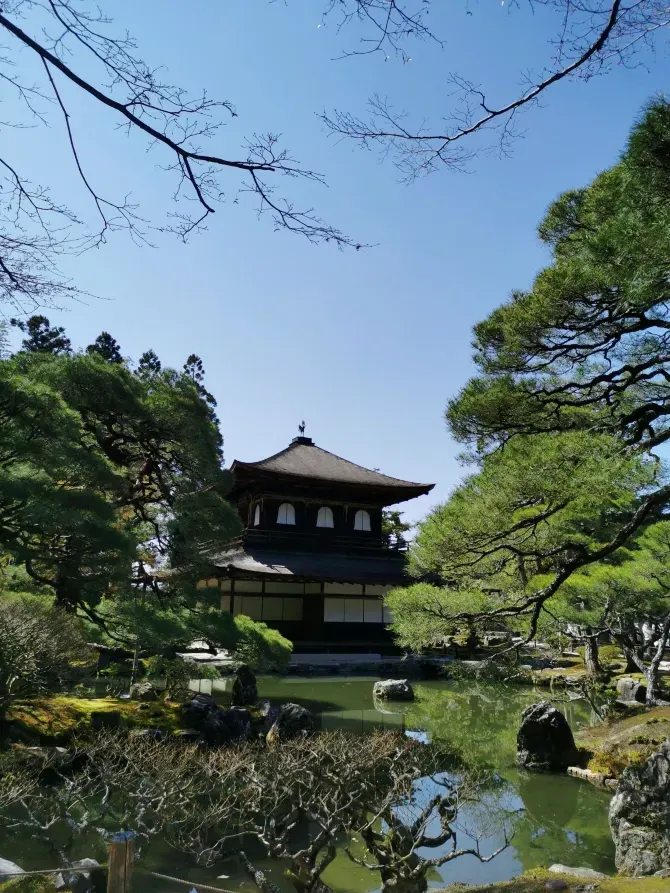
The Ginkakuji Temple in Kyoto. Source: Trip.com @ LMOOLM
Are you ready to embark on an adventure to one of Japan's most beautiful destinations? Look no further than Kyoto's Ginkakuji, the magnificent Silver Pavilion that will take you to a world of tranquility and beauty. Every feature of Ginkakuji, from the beautiful gardens to the gleaming silver exterior, is a psalm to the creativity and grace of Japanese culture.
As you explore the holy temple grounds, you'll be struck by the peaceful and serene atmosphere. The gardens are well-maintained and provide a beautiful backdrop for the temple buildings and monuments. This Kyoto temple is known for its beautiful gardens and the iconic silver pavilion, which sparkles in the sunlight and casts a wonderful reflection on the nearby pond.
The cost of admission to Ginkakuji is subject to variation based on the time of year, and the temple is open daily from 8AM to 5PM. If you're visiting during peak season, which spans from March to May and September to November, you can expect to pay around $4.50 for a ticket. On the other hand, if you plan to visit during the off-peak season of June to August or December to February, the cost of a ticket will be approximately $3.
Address: 2 Ginkakujicho, Sakyo, Kyoto, 606-8402, Japan
6.Nanzen-ji
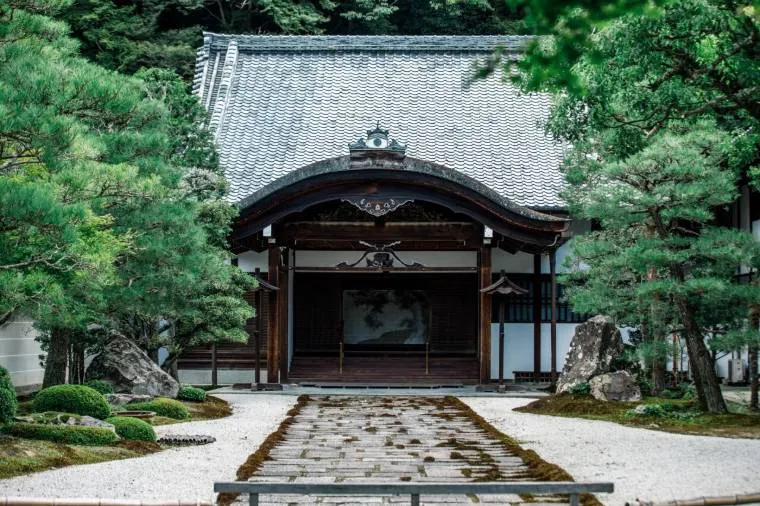
kyoto temple - Nanzen-ji. Source: Trip.com
Are you dreaming of a trip to Kyoto, Japan? Don't miss out on the breathtaking beauty of Nanzen-ji temple, one of the key temples in Kyoto. This stunning temple is a true reflection of the rich cultural heritage of Japan. Visitors can walk on the expansive grounds and discover the beautiful gardens that make Nanzen-ji out of this world, and don't forget to take a photo in front of the historic Sanmon gate, one of the largest and most impressive temple gates in all of Japan.
Located at the base of the Higashiyama mountains, this temple is open daily from 9AM to 5PM, so you can plan your visit at your convenience. If you're planning a visit to the Nanzen-ji temple, then you're in for a treat. At just approximately $5 for adults and $4 for children, you can step into one of the most amazing Kyoto temples.
Address: 86 Nanzenji Fukuchicho, Sakyo, Kyoto, 606-8435, Japan
7.Toji Temple
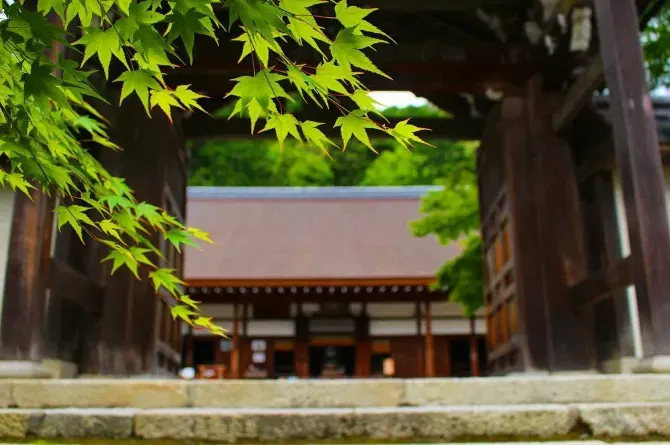
The beautiful Toji Temple. Source: Trip.com
To-ji Temple, also known as Kyoo-Gokoku-ji Temple, is a hidden gem in Kyoto, Japan. Located just a short walk from Kyoto Station, To-ji Temple is one of the most impressive and historically significant temples in Kyoto. The defining feature of To-ji Temple is the majestic five-story pagoda, which stands over 55 meters (around 180 ft.) tall and is the tallest wooden pagoda in Japan. The pagoda is a true masterpiece of Japanese architecture and design, and visitors can climb to the top for amazing views of the city.
The temple is home to other buildings and monuments as well, including the Kondo Hall, a gorgeous hall that houses a beautiful statue of the Buddha. After a fire in 1486 that destroyed the original building, it was later reconstructed during the Edo Period (from 1603 and 1867) in a contemporary style that is sure to impress. Today, it is home to Toji's most prized possession - a stunning wooden statue of the Yakushi Buddha, guarded by two Bodhisattvas, Nikko and Gakko.
If you're planning to visit To-ji Temple, tickets cost around $5 per person. The temple is located just a short walk from Kyoto Station, making it easily accessible by public transportation. This Kyoto temple is open daily from 9:00AM to 4:30PM.
Address: 1 Kujocho, Minami Ward, Kyoto, 601-8473, Japan
8.Daitoku-ji Daisen-in
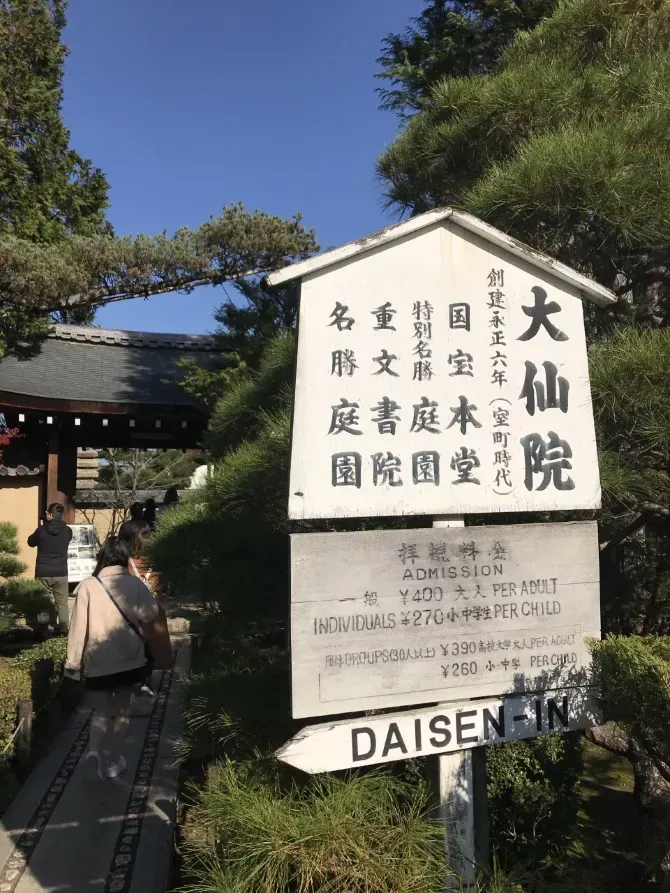
The Daitoku-ji temple. Source: Trip.com
From ancient temples to historic shrines, Kyoto has it all! Each one has a story of its own that will leave you captivated for days to come. But amidst all these incredible wonders, the Daitoku-ji temple stands out among other temples in Kyoto. The temple is home to many prominent buildings and monuments, including a lovely tea house that offers visitors the chance to experience a traditional Japanese tea ceremony.
The key feature of Daitoku-ji Daisen-in is the beautiful rock garden, which is known for its relaxing and meditative qualities. The garden is designed to represent a mountainous landscape, with carefully placed rocks and gravel that create the impression of a flowing river. The stunning rock garden is the brainchild of none other than Soseki Muso, a Zen priest and garden designer who is a household name in Japan.
For those planning to visit this temple in Kyoto, tickets cost around $6 per person, and the temple is open to visitors from 9:00AM to 5:00PM daily.
Address: Murasakino Daitokujicho, Kita, Kyoto, 603-8231, Japan
9.Ryōan-ji

Beautiful Zen gardens. Source: Trip.com
Are you feeling overwhelmed by the hustle and bustle of city life? If so, I've got a hidden utopia that'll transport you to a world of peace and serenity. Say hello to Ryōan-ji temple in Kyoto, a hidden gem housed amidst lush greenery in the north. Ryoan-ji Temple, located in Kyoto's northwest, is home to a rock garden that is nothing short of legendary. This garden is a work of simplicity and elegance, with 15 rocks carefully placed in five groups on a bed of white gravel.
The temple also has a stunning pond garden, which is home to numerous bird and fish species. The surrounding nature creates a sense of peace, and visitors often take their time to explore the temple grounds and enjoy the beautiful scenery. If you're making your way to Ryōan-ji Temple, here's the scoop: admission will cost you $4.50 for adults and $3.50 for the little ones. And the good news is: the temple is open from 8:00AM to 5:00PM every single day, so you have plenty of time to marvel at all its beauty.
Address: 13 Ryoanji Goryonoshitacho, Ukyo, Kyoto, 616-8001, Japan
10.Kamigamo Jinja
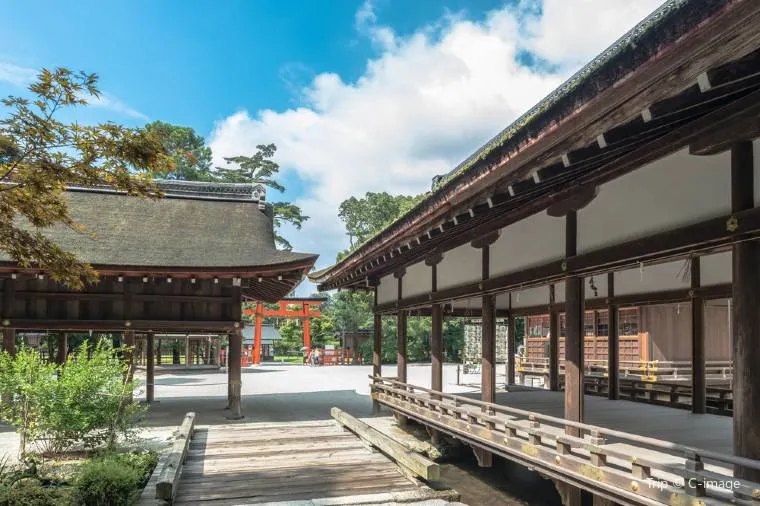
Kamigamo Jinja. Source: Trip.com
Kamigamo Jinja, also referred to as Kamowakeikazuchi Shrine, is located in the northern part of Kyoto and is a designated UNESCO World Heritage Site. While there, prepare to travel back in time to the 7th century, where one of Japan's oldest shrines awaits you. This iconic shrine is dedicated to none other than the gods of thunder and water, making it a must-visit destination for those seeking blessing from the almighty.
One of the key features of this Kyoto temple is its massive, ancient wooden torii gate that stands over 10 meters (around 32 ft.) tall. The torii gate is the titan of its kind, and it is a truly breathtaking sight to behold. Visitors are encouraged to pass through the gate and explore these holy grounds, where they can learn more about Shinto rituals and traditions.
If you're planning to visit Kamigamo Jinja, tickets cost around $5 per person, and the shrine is open daily from 9:00AM to 4:30PM.
Address: 339 Kamigamo Motoyama, Kita Ward, Kyoto, 603-8047, Japan
11.Honnoji Temple
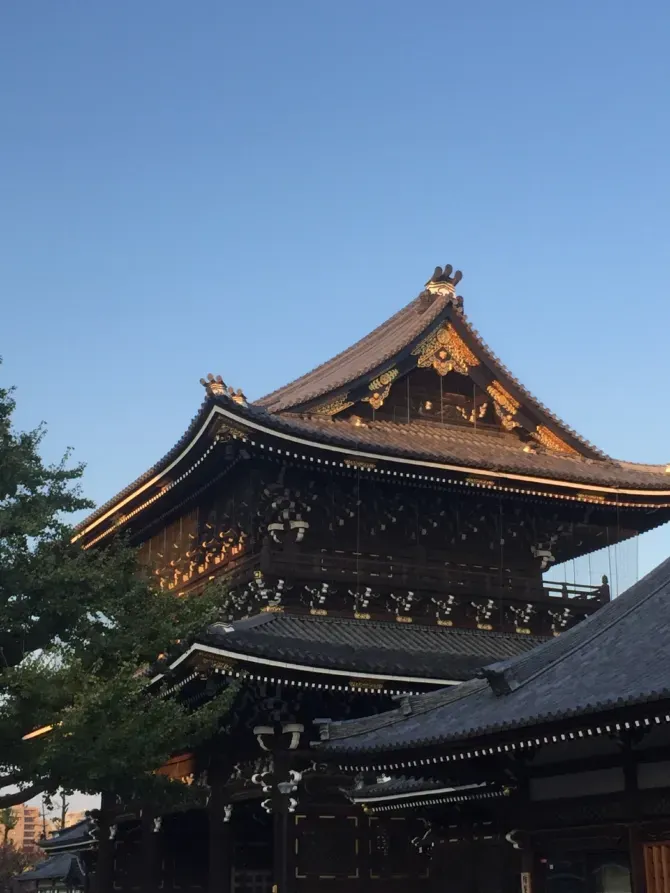
shimohonnjimaech.Source: Trip.com
If you're a history and culture buff, then you shouldn't miss the Honnoji Temple, which resides in the heart of Kyoto. It is a top destination for anyone interested in Japanese history and culture. The temple is well-known for its crucial role in Japan's history on top of its beauty and peaceful ambiance, which makes it a popular tourist destination.
Prepare to be blown away by the magnificent main hall of Honnoji Temple. This impressive structure houses a wooden statue of the one and only Shaka Nyorai, a prominent Buddhist deity. But the real star of the show is the famed architecture that'll transport you straight back to the Muromachi period (approximately 1336 to 1573).
What distinguishes Honnoji Temple is its historical significance. The shrine witnessed a pivotal event in Japanese history in 1582: the assassination of the great daimyo Oda Nobunaga (a prominent figure regarded as the first "Great Unifier" of Japan.) by one of his own vassals. Visitors can now observe a stone monument commemorating the place where Nobunaga was assassinated.
Want to learn about Japanese history and culture without breaking the bank? Honnoji Temple has you covered with an admission charge of only $5 for adults and $3 for children. And with the temple doors open every day from 9:00am to 5:00pm, you can plan your visit whenever it suits your schedule.
Address: 522 Shimohonnojimae-cho, Teramachi-dori, Nakagyo, Kyoto, 604-8091, Japan
12.Matsuo-taisha
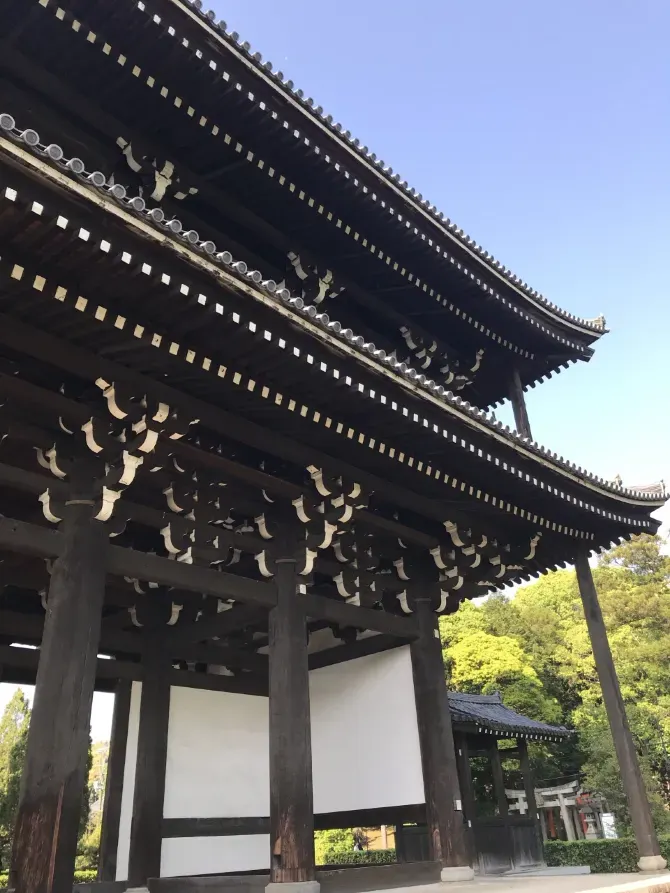
Matsuo-taisha. Source: Trip.com
Matsuo-taisha, a Shinto shrine in the foothills of western Kyoto, has been a popular pilgrimage site for generations. Matsuo-taisha's most notable feature is its lovely natural surroundings, which include a deep forest and a flowing river. It honors the god of water and mountains and is one of Japan's most cherished and ancient temples in Kyoto.
Matsuo-taisha's relationship to the cyclical nature of the seasons is among its most unique features. The temple is particularly known for its spring cherry blossoms and fall foliage. Visitors can see the transformation of the forest into a breathtaking display of color and beauty on the grand scroll of nature.
This temple in Kyoto is about 30 minutes by bus from Kyoto Station, and admission to the shrine costs roughly $2 per person.
Address: 3 Arashiyama-miyamachi, Nishikyo, Kyoto, 616-0024, Japan
13.Tofukuji Temple
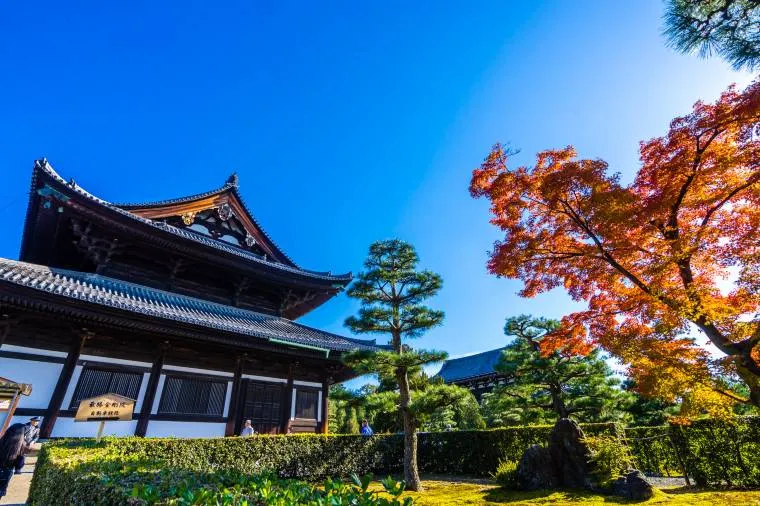
The magnificent Tofukuji temple. Source: Trip.com
Located in the picturesque Higashiyama District of Kyoto, Tōfuku-ji Temple is a top destination for any traveler exploring the ancient capital of Japan. Tofukuji Temple offers a spiritual and cultural experience that is positive and enlightening. It can attain such an effect by providing a calm and quiet environment, beautiful architecture, and a rich history rooted in Japanese tradition.
As one of the oldest and largest temples in Kyoto, Tofukuji Temple boasts a rich history dating back to the 13th century. The Hojo, the Kaisando, and the Miedo are just a few of the many halls and buildings that make up the temple complex. Each building offers a unique glimpse into the art and architecture of Japan's medieval period. Ticket prices for Tofukuji Temple are reasonable, with a basic entrance fee of $3.50.
Address: 15-778 Hon-machi, Higashiyama Ward, Kyoto, Kyoto Prefecture, 605-0981, Japan
14.Mibu-dera Temple
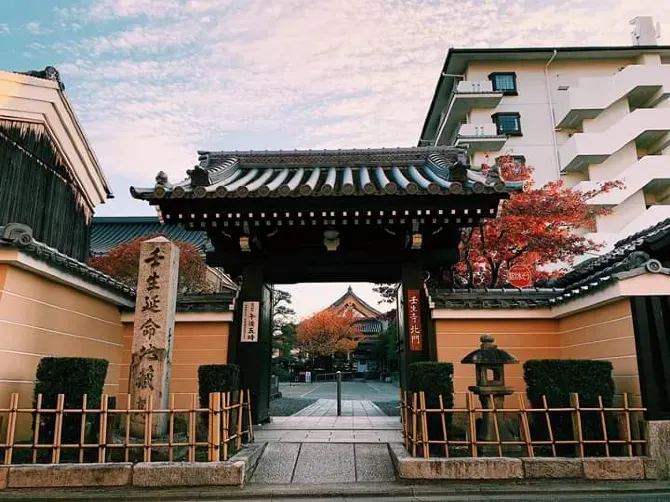
Mibu-dera Temple. Source: Trip.com
Tucked away in the charming Mibu neighborhood of Kyoto lies a hidden paradise that often goes unnoticed by tourists - the Mibu-dera Temple. One of the key features of Mibu Temple is its connection to the Shinsengumi, a legendary group of samurai who served as the police force of Kyoto during the late Edo period (roughly from 1603 and 1867). Mibu Temple served as Shinsengumi's training ground, and tourists may still view the dojo where they perfected their skills.
Mibu-dera Temple is easily accessible from central Kyoto, as it is only a short walk from Mibu-dera Station on the Hankyu Line. The temple's admission fee is $5, making it an economical addition to all travelers' itineraries. This temple in Kyoto is open daily from 8:30AM to 5:30PM.
Address: 31 Mibunaginomiyacho, Nakagyo, Kyoto, 604-8821, Japan
15.Heian-jingu Shrine
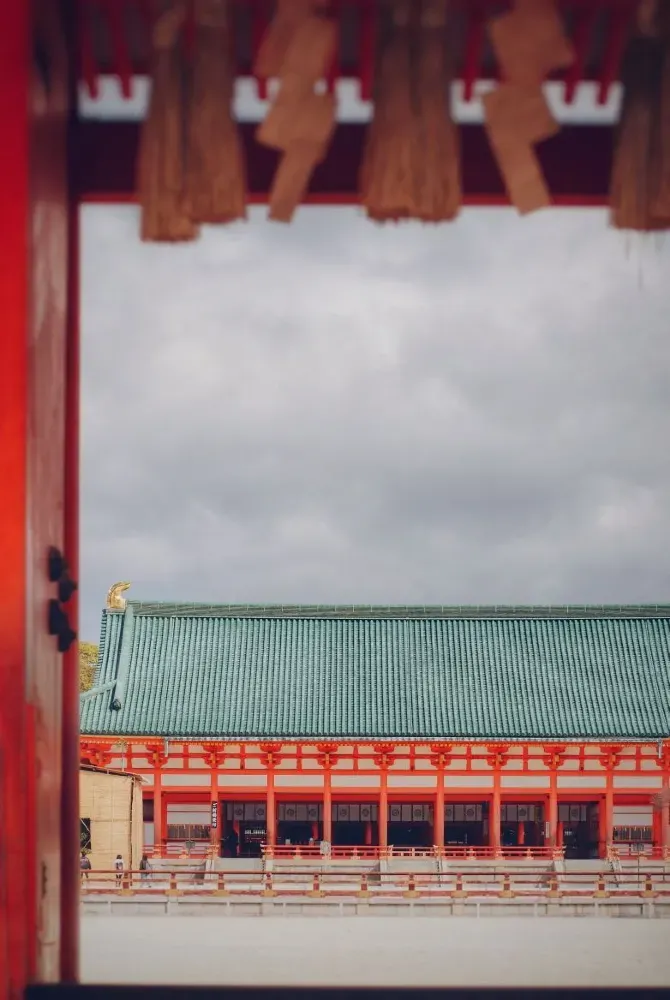
A charming garden. Source: Trip.com
Heian-jingu Shrine is one of the most famous and beautiful temples in Kyoto. The shrine, founded in 1895, is a testimony to Japan's rich cultural heritage. The Heian-jingu Shrine honors Kyoto's first and last emperors, Emperor Kammu and Emperor Komei.
The beautiful architectural design of Heian-jingu Shrine, which combines Japanese and Chinese design elements, constitutes its defining features. The shrine's main building is a replica of the ancient Imperial Palace, which was constructed during the Heian period (from 794 to 1185). Beautiful gardens showcase the elegance of Japanese landscape design philosophy at that time.
The admission fee to the shrine is approximately $5, and it is open daily from 6:00AM to 5:30PM. It is recommended to visit during the high cherry blossom season in spring or the autumn foliage season in fall to experience the changing seasons.
Address: Okazaki Nishitennocho, Sakyo Ward, Kyoto, 606-8341, Japan
16.Kitano Tenmangu Shrine
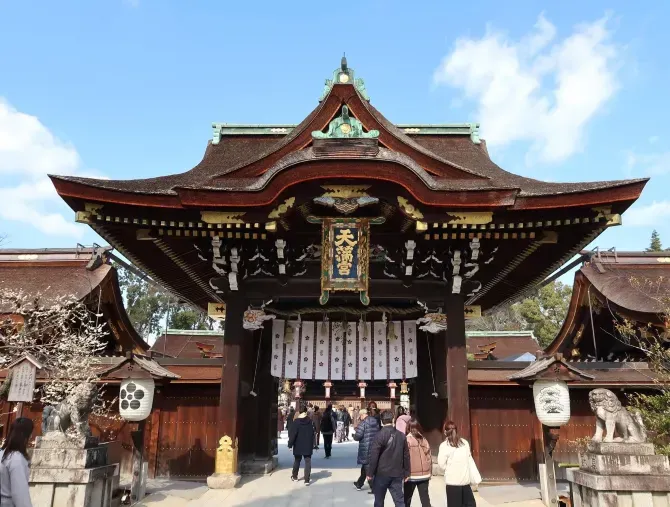
Kitano Tenmangu Shrine. Source: Trip.com
Welcome to Kitano Tenmangu Shrine, a one-of-a-kind and inspiring shrine in Kyoto, Japan. This shrine is dedicated to Sugawara no Michizane, a Heian period scholar and statesman who is regarded as the god of learning and the patron of scholars.
For those looking to embark on a spiritual journey without overdrawing, a visit to Kitano Tenmangu Shrine wouldn't disappoint you. The entrance fee to this magnificent shrine is about $4.50 for adults and $3 for children. With doors open every day from 5:00AM to 6:00PM, this temple in Kyoto is a favored destination among tourists and locals alike.
Address: Bakurocho, Kamigyo Ward, Kyoto, Kyoto Prefecture 602-8386, Japan
17.Higashi Honganji Temple
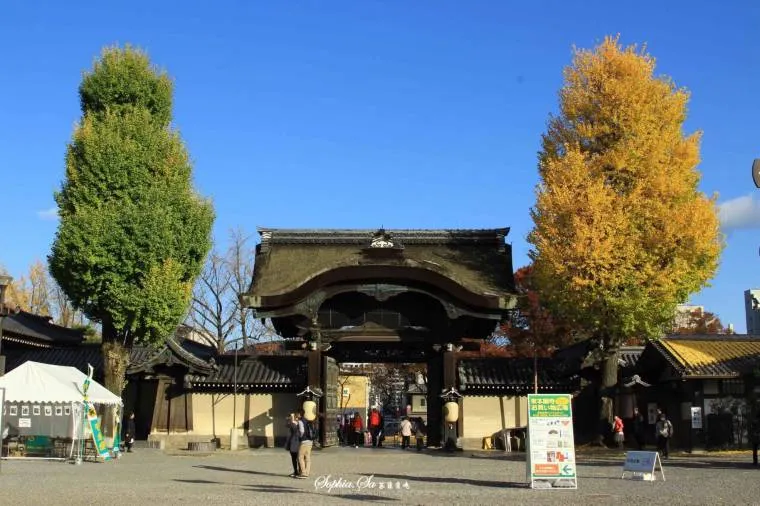
Higashi Honganji Temple. Source: Trip.com
Higashi Honganji Temple, one of the largest and most famous temples in Kyoto, Japan, is a spiritual and cultural lighthouse that draws tourists from all over the world. Situated just a short walk from Kyoto Station, this temple in Kyoto is one of the largest wooden structures in the world, with a history dating back over 400 years. Tokugawa Ieyasu, the first shogun (general) of the Edo era, founded the temple in 1602 as a memorial to his predecessor, Toyotomi Hideyoshi.
Tickets to enter the temple grounds are free, but there is a fee for guided tours of the temple buildings' interiors. These tours provide guests with the opportunity to learn more about the history and significance of Higashi Honganji Temple, as well as get up close with some of its most stunning architectural aspects.
18.Seimei Shrine
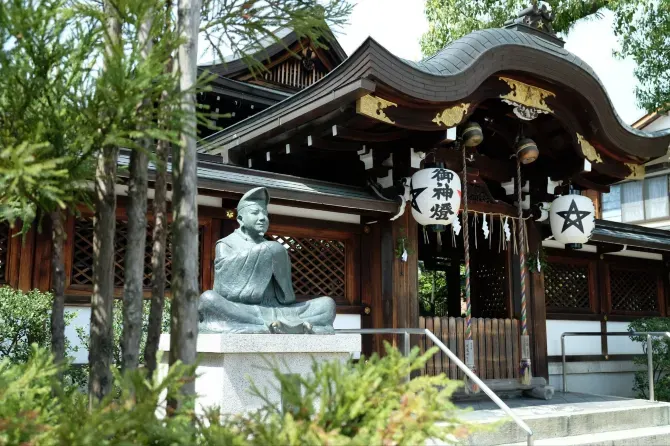
Seimei Shrine. Source: Trip.com
There are several shrines and temples in Kyoto that provide insight into Japan's rich history and culture, and the Seimei Shrine, dedicated to the great astronomer Abe no Seimei, is one of them. The Seimei Shrine is said to have been built on the site of Abe no Seimei's former home. The beautiful torii gate constructed of cypress wood that stands at the shrine's entryway is one of its most notable features.
The admission fee for the Seimei Shrine is approximately $3, and the shrine is open every day from 9AM to 5PM and can be easily accessed by public transportation.
Address: 806 Horikawa Dori, Ichijo-agaru, Kamigyo Ward, Kyoto, Kyoto Prefecture, 602-8222, Japan
19.Shodenji Temple
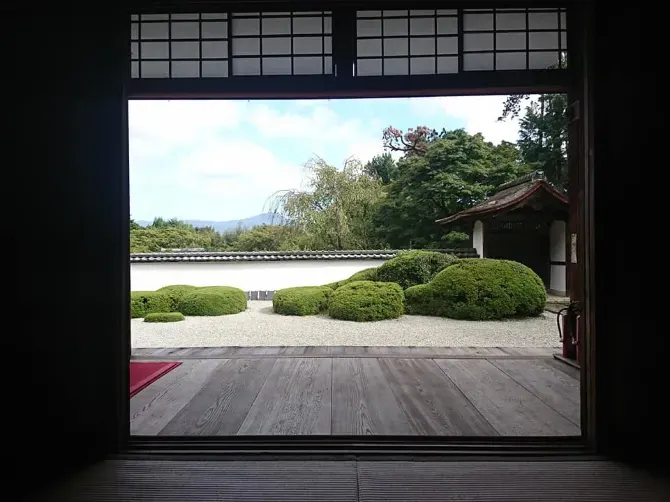
Shodenji Temple. Source: Trip.com
Are you up for discovering a hidden gem in the heart of Kyoto? Shodenji Temple, one of the most iconic temples in Kyoto, is a serene haven constructed in 1282 by the great Buddhist monk Kakujun. Shodenji Temple was originally built as a place for deep meditation and learning. That has since bloomed into a charming experience for all the senses, capturing tourists with its gorgeous gardens and spectacular architecture.
Located just a stone's throw away from the renowned Ginkaku-ji temple, this temple in Kyoto charges admission fees of about $4.50, and visitors can enjoy a complimentary cup of green tea and a sweet in the temple's tea room.
Address: 72 Nishigamo Kitachinjuan-Cho, Kita-Ku, Kyoto 603-8847 Kyoto Prefecture
20.Tenryuji Temple
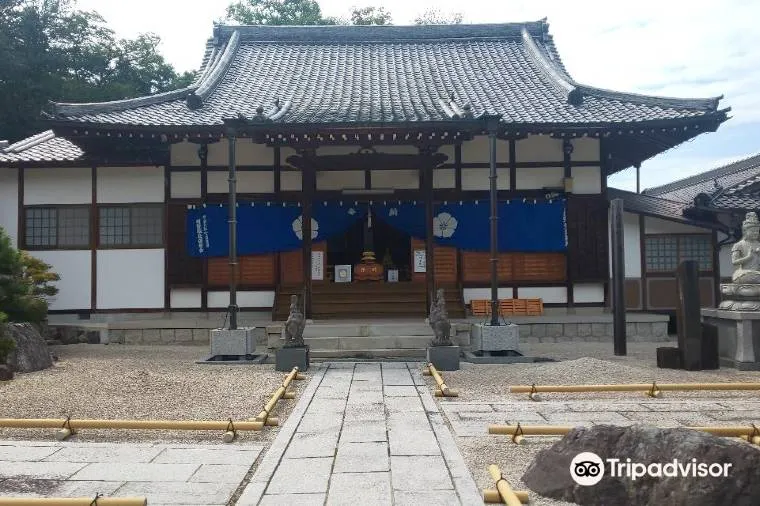
Tenryuji Temple
Experience the charming beauty of Kyoto's Arashiyama district. Within it lies the peaceful oasis that is Tenryuji Temple. With its serene surroundings, this temple sends out a welcoming vibe that frees modern people from the hustle and bustle of Kyoto.
The temple was established in 1339 as a tribute to Emperor Go-Daigo by the governing shogun Ashikaga Takauji. The temple has undergone various repairs and reconstructions over the years, but its tranquil ambiance has remained unchanged. Tickets to this temple in Kyoto cost $5 for adults and $3 for children, and the temple is open from 8:30AM to 5:30PM daily.
Address: Sagatenryuji Susukinobabacho, Ukyo, Kyoto, 616-8385, Japan
Kyoto's Top Three Hotels that Redefine Cool
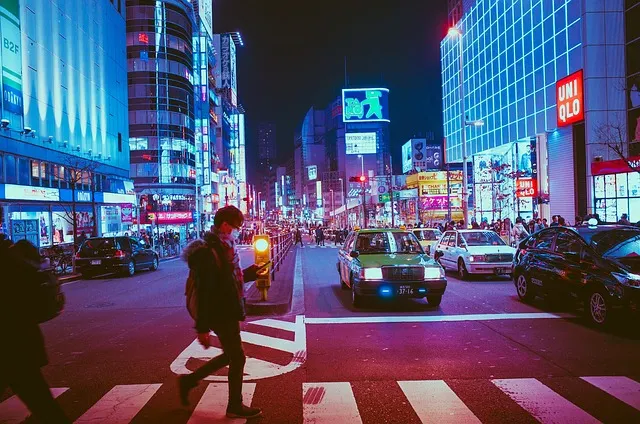
Pedestrians crossing the street. Source: Masachi Wakui from Pixabay
Kyoto is the ideal city for you if you're seeking a place that blends traditional Japanese culture with modern conveniences. And staying at one of the city's hippest hotels is the best way to experience its distinct vibe. These three hotels are the synonym for a great stay in Kyoto, from stylish minimalistic decor to charming traditional designs. Prepare to experience first-rate hospitality in these accommodations offering a world of wonder that will lure you to come back for more.
Ace Hotel Kyoto

Sumptuous Sushi. Source: Adamsov Production from Pixabay
As you are strolling through the charming streets of Kyoto, it's hard to miss the eye-catching Ace Hotel, beckoning you with its sleek exterior as if holding out a welcoming hand to draw you in for some fun. This boutique hotel is a breath of fresh air in a city known for its traditional charm, and it offers a welcoming ambiance for visitors. The Ace Hotel Kyoto is a short distance away from the city's renowned attractions, such as the Kyoto Imperial Palace and the bustling Nakagyo neighborhood's Nishiki Market.
The hotel is open around-the-clock, so visitors may take advantage of its services whenever they fancy. The Ace Hotel Kyoto features a ton of amenities, such as a well-stocked gym, a tranquil rooftop garden, and an outdoor bar where visitors can enjoy a refreshing drink. The hotel also features a shop where local designers and artists are featured, thereby allowing visitors to bring a little bit of Kyoto's traditional style back home with them.
But what about the price, one may ask? A night's stay at Ace Hotel Kyoto starts at around $350, and the experience is worth every penny. It stands out as an excellent option for anyone seeking a genuinely memorable stay in Kyoto because of its excellent location, impeccable design, and commitment to sustainability.
Nazuna Kyoto Gosho
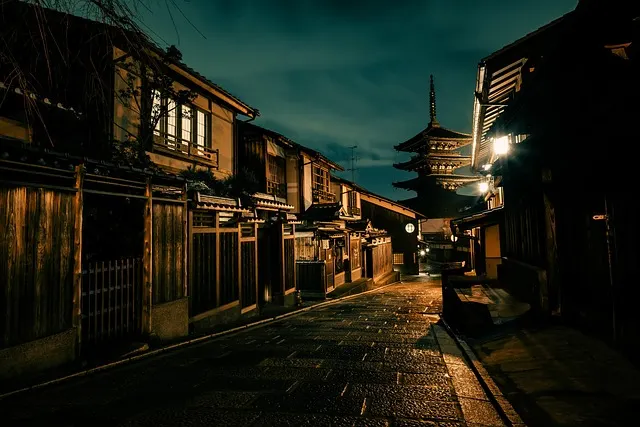
An Alley of Kyoto at Night. Source: Kanenori from Pixabay
Nazuna Kyoto Gosho, a gorgeously renovated machiya (traditional Japanese townhouse) from the Edo era, is only a short stroll from the Kyoto Imperial Palace. Each of the hotel rooms features its own Japanese garden aesthetic, tatami floors, and a deep soaking tub. Each room is attractively furnished with a mix of modern and traditional elements.
But the dedication to personal attention at Nazuna Kyoto Gosho is what really sets it apart from others. The attentive personnel at the hotel will go above and beyond from the moment you arrive till the moment you check out. Hotel staff will spare no effort to make sure that your stay is 100% satisfactory. To make your time in Kyoto as relaxing as possible, the hotel staff can assist with organizing everything from dinner reservations to city excursions.
As for the hotel's opening hours, they are open 24/7 for guests to enjoy, and a night's stay at Nazuna Kyoto Gosho can range from $500 to $1,000, depending on the season and room type. Guests can conveniently walk or hop onto some public transportation to reach the magnificent Golden Pavilion and Ryoanji Temple easy-peasy.
Kyoto Granbell Hotel

Vibrant Japanese lanterns. Source: xegxef from Pixabay
The Kyoto Granbell Hotel is the pinnacle of luxury. It skillfully combines modern amenities with Japanese culture to give visitors an enjoyable stay. This opulent hotel boasts an unmatched location and outstanding amenities. Therefore, it is the ideal choice for those seeking an authentic Japanese travel experience.
The Kyoto Granbell Hotel is well-positioned for anyone wishing to enjoy the city's dynamic cultural scene. It is only a short distance away from the famous Nishiki Market and the bustling shopping district of Shijo-Kawaramachi. Kyoto Granbell Hotel is open around-the-clock, ensuring that guests can access the hotel's amenities and services at all times.
The Kyoto Granbell Hotel's dedication to sustainability is one of its most notable qualities. As a result of the hotel's strenuous effort to bring out all sorts of eco-friendly activities, such as using renewable energy and minimizing waste, it is a fantastic option for tourists who wish to make concrete efforts to better the environment.
A night's stay at Kyoto Granbell Hotel starts at around $150, making it one of the more affordable options in Kyoto's busy downtown area. Their service shall always maintain at the highest caliber, despite their lower charges compared to others.
Unlocking the Secrets of Kyoto: Insider Travel Tips for Your Next Adventure

Amazing Heian Shrine. Source: David Mark from Pixabay
If you're planning a trip to Japan, then Kyoto is an absolute must-visit destination, boasting a rich history and cultural heritage that's hard to match. But, let's be honest, organizing a vacation to this ancient city can be a bit overwhelming, especially if you're a first-time tourist. That's why we're here! Check out these essential travel tips to make the most of your time in Kyoto and experience this magnificent city to the fullest. Let's get started!
Weather and Clothing Tips

Magnificent fall leaves. Source: DerWeg from Pixabay
Kyoto has four distinct seasons, with each having a beauty of its own. The best time to visit is during spring, which starts from March to May, and fall, which starts from September to November when the weather is pleasant, and the scenery is spectacular. Summers can be quite hot and humid, while winters can be very cold and snowy.
Since Kyoto's weather can be unpredictable, make sure to dress in layers that are easy to slip on and off throughout the day. And since you'll likely be doing a lot of walking, especially if you plan to explore the shrines and temples in Kyoto, a nice pair of comfy shoes is in order. So, grab your comfiest kicks and get ready to take on Kyoto in style!
Best Time to Visit Temples in Kyoto

The charming temples of Kyoto. Source: aibo0309 from Pixabay
Spring is famous for the cherry blossoms, while autumn is renowned for its vibrant fall foliage. Summer is ideal for outdoor gatherings, while winter allows you to build a snowman and enjoy seasonal delights.
Do's and Don'ts When Visiting Temples in Kyoto
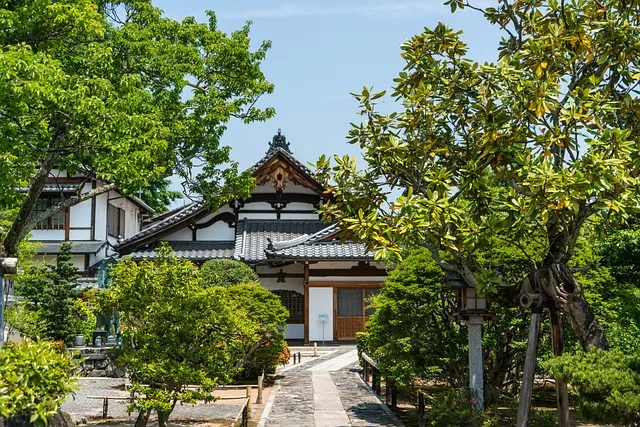
The magnificent Arishayama Temple. Source:Michelle Raponi from Pixabay
When visiting temples in Kyoto, there are certain etiquettes that one must follow. To begin with, it is important to remove your shoes before entering the temple. Additionally, one should bow when entering and leaving the main hall as a sign of respect. It is also important to adhere to the no-photography signs and to avoid taking photographs of people without their permission.
As for the dress code, it is recommended to avoid wearing revealing clothing and should dress appropriately. Besides, there are certain actions that should be avoided while visiting the temples in Kyoto. These include touching or disturbing any objects or structures, entering closed-off areas, and speaking loudly or making unpleasant noise. By following these guidelines, one can show respect and appreciation towards the Kyoto temples and the history behind them.
Kyoto Temple
-
What is Kyoto's famous temple?
A must-see in Kyoto, the Zen Buddhist shrine known as Kinkakuji Temple or 'Temple of the Golden Pavilion' attracts countless visitors and holds a UNESCO World Heritage site designation.
-
What is the nicest part of Kyoto?
Downtown Kawaramachi is considered the optimal location for tourists seeking accommodation in Kyoto.
What are the oldest temples in Kyoto?
Established in the year 1202 CE, Kennin-ji asserts itself as the oldest Zen temple located in Kyoto.
What is the most beautiful town in Kyoto?
Renowned for its old-school beauty and top-class sake, Hida-Takayama has earned the nickname 'Little Kyoto' due to its wealth of shrines, temples, and charming 18th-century architecture.
Which month is best for Kyoto?
The best times to visit Kyoto for a comfortable exploration is between March to May and September to November, as the weather during these periods is mild and pleasant.
How many temples are in Kyoto?
Kyoto boasts over 1600 Buddhist temples and 400 Shinto shrines.
